Engine idle speed check (Every 6000 miles (10 000 km) or 6 months)
Caution: Refer to the precautions in Section 1, Chapter 4, Part A or B (as applicable), before proceeding.
Before carrying out any carburettor adjustments, ensure that the ignition timing and spark plug gaps are set as specified. To carry out the adjustments an accurate tachometer and an exhaust gas analyser (CO meter) will be required.
Ford VV carburettor
1 Ensure that the air cleaner is correctly fitted,
and that all vacuum hoses and pipes are
securely connected and free from restrictions,
then run the engine until it is at normal
operating temperature.
2 Stop the engine, and connect a tachometer and an exhaust gas analyser in accordance with the manufacturer’s instructions.
3 Start the engine and run it at 3000 rpm for 30 seconds, ensuring that all electrical loads are switched off (headlamps, heater blower etc), then allow the engine to idle and check the idle speed and CO content. Note that the CO reading will initially rise, then fall and finally stabilise after between 5 and 25 seconds.
4 If necessary, adjust the idle speed screw to give the specified idle speed (see illustration).
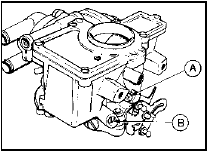
15.4 Ford VV carburettor adjustment screw locations
A Idle speed screw B Idle mixture screw
5 Checking and adjustment should be completed within 30 seconds of the meter readings stabilising. If this has not been possible, repeat paragraphs 3 and 4, ignoring the reference to starting the engine.
Weber 2V carburettor
Models without stepper motor
6 Proceed as described for the Ford VV
carburettor but note the following:
7 It is permissible to loosen the air cleaner
securing screws to allow easier access to the
carburettor adjustment screws but ensure
that all vacuum hoses and pipes are securely
connected. For adjustment screw location
(see illustrations).
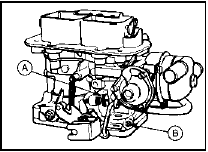
15.7a Weber 2V carburettor adjustment screw locations - 2.0 litre models up
to 1985
A Idle speed screw B Idle mixture screw
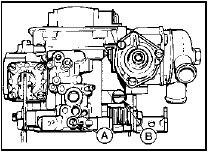
15.7b Weber 2V carburettor adjustment screw locations - 1.6 litre models
A Idle mixture screw B Idle speed screw
Models with stepper motor (ESC II
system)
8 The idle speed is controlled by the ESC II
module via the stepper motor. The only idle
speed adjustment possible is provided by the
“idle speed adjustment” wire, which can be
earthed to raise the idle speed by 75 rpm. No
other method of idle speed adjustment should
be attempted. If the idle speed is incorrect,
the problem should be referred to a Ford
dealer, as the problem probably lies in the
ESC II module for which special diagnostic
equipment is required.
Pierburg 2V carburettor
9 Proceed as described for the Ford VV
carburettor. For adjustment screw location
(see illustration).
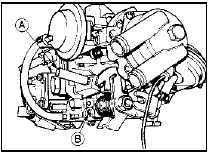
15.9 Pierburg 2V carburettor adjustment screw locations
A Idle speed screw B Idle mixture screw
Weber 2V TLD carburettor 10 Proceed as described for the Ford VV carburettor, noting the following points: 11 Ensure that the vacuum pipe and the camshaft cover breather hose are securely connected to the air cleaner and are free from restrictions.
12 When warming-up the engine, run the engine until the cooling fan cuts in.
13 For adjustment screw location (see illustration).
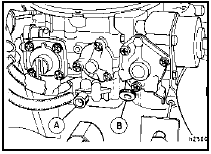
15.13 Weber 2V TLD carburettor adjustment screw locations
A Idle mixture screw B Idle speed screw
Fuel injection
2.0 litre SOHC models
14 Idle speed is controlled by the EEC IV
module and the only means of adjustment
provided is by the yellow “idle speed
adjustment” wire (Chapter 5, Section 17) which
allows the idle speed to be raised by 75 rpm.
2.0 litre DOHC models
15 Idle speed is controlled by the EEC IV
module, and manual adjustment is not
possible.
16 The “base” idle speed can be adjusted, but only by a Ford dealer, using special equipment.
See also:
Auxiliary shaft - removal, inspection and refitting
Note: A new gasket should be used when
refitting the auxiliary shaft cover (see text).
Removal
1 Remove the timing belt and the auxiliary
shaft sprocket.
2 Remove the distributor.
3 Remove the m ...
Air cleaner assembly - removal and refitting
Removal
1 Disconnect the battery negative terminal.
2 Disconnect the crankcase ventilation hoses
which are accessible from above, from the air
cleaner body (see illustration).
2.2 Disconnecting ...
Manifold Absolute Pressure (MAP) sensor - removal and refitting
Removal
1 Disconnect the battery negative lead.
2 Disconnect the sensor wiring plug (see
illustration). Do not pull on the wiring.
16.2 Manifold absolute pressure (MAP) sensor - 1.4 CFI engine
...
